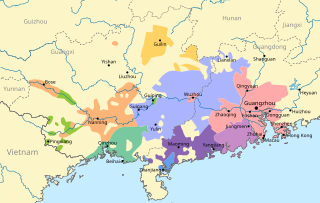

| Qin-Lian Yue | |
|---|---|
| Hamlim Jijin / Hamlim Jujin | |
| Native to | China |
| Region | Guangxi |
Native speakers | About 3,900,000 (2013)[1] |
| |
| Language codes | |
| ISO 639-3 | None (mis) |
| ISO 639-6 | qnli |
| Glottolog | qinl1235 |
| Linguasphere | 79-AAA-mf |

Qin-Lian (lower left), among other Yue and Pinghua groups in Guangxi and Guangdong | |
The Qin–Lian language (Hamlim JijinorHamlim Jujin; Chinese: 欽廉语言; from the names of Qinzhou and Lianzhou) is a southern branch of Yue Chinese spoken in the coastal part of Guangxi, including 3 main cities: Beihai, Qinzhou, Fangchenggang, and four subject counties: Hepu, Pubei, Lingshan, Dongxing.
Qin–Lian refers to Qinzhou (Hamzau/Yamchow) and Lianzhou (Limzau/Limchow), the latter being the former name of Hepu and the historical prefecture of Guangdong it commanded. Other collective names for these areas include 'Beihai-Qingzhou-Fangchenggang' (Chinese: 北欽防) and 'Beibu Gulf Area' (Chinese: 北部灣地區).
Middle Chinese had a series of voiced initials, but voicing has been lost throughout Yue and most other modern Chinese varieties apart from Wu and Old Xiang. The reflexes of the voiced stops and affricates are often used to classify Chinese varieties.
In most Qin–Lian varieties, these consonants develop into aspirates in all tones, a pattern also found in Wu–Hua Yue and Hakka,[2][3] which is also the traditional criterion of Qin-Lian Yue. However, in urban Qin–Lian varieties they yield aspirates in the level and rising tones, and non-aspirates in the departing and entering tones,[2] the same pattern found in the Guangfu, Siyi and Gao-Yang branches of Yue.[3] In spite of distinguishable but tiny differences on phonology and vocabulary, there is high mutual intelligibility and a great number of common colloquial words in the urban varieties and furthermore, in some varieties of Yong-Xun and Gao-Yang. Those features along with its scattered speaking zones may reflect the influence of intercity commercial communication in history, and lead to a lasting debate on its classification.[2]
The table below shows the differences in phonology among Cantonese varieties.
| Sound changes | IPA | Qinzhou | Fangcheng | Lingshan | Beihai |
|---|---|---|---|---|---|
| Vowel breaking of "i" |
/i/ > /ei/ | no | no | some words | yes |
| ou > au merger | /ǝu/ > /ɐu/ | yes | yes | no | yes |
| oe > e merger | /øɔ/ > /eɐ/ |
younger speakers | some speakers | yes | yes |
| i > z shifting | /i/ > /ɿ/ |
no | some speakers, mainly young female | no | some speakers,
which might be influenced by other language. |
| Terminal consonants merger,
mix or miss |
/-p/ /-t/ /-k/ > /-ʔ/ |
no | no | no | some younger speakers |
|
Sino-Tibetan branches
| |||||
|---|---|---|---|---|---|
| Western Himalayas (Himachal, Uttarakhand, Nepal, Sikkim) |
| ||||
| Eastern Himalayas (Tibet, Bhutan, Arunachal) |
| ||||
| Myanmar and Indo-Burmese border |
| ||||
| East and Southeast Asia |
| ||||
| Dubious (possible isolates) (Arunachal) |
| ||||
| Proposed groupings |
| ||||
| Proto-languages |
| ||||
Italics indicates single languages that are also considered to be separate branches. | |||||
|
| |||||||||||||||||||||||||||||||||||||||||||||||||||||||||||||||||||||
|---|---|---|---|---|---|---|---|---|---|---|---|---|---|---|---|---|---|---|---|---|---|---|---|---|---|---|---|---|---|---|---|---|---|---|---|---|---|---|---|---|---|---|---|---|---|---|---|---|---|---|---|---|---|---|---|---|---|---|---|---|---|---|---|---|---|---|---|---|---|
| Major groups |
| ||||||||||||||||||||||||||||||||||||||||||||||||||||||||||||||||||||
| Standard forms |
| ||||||||||||||||||||||||||||||||||||||||||||||||||||||||||||||||||||
| Phonology |
| ||||||||||||||||||||||||||||||||||||||||||||||||||||||||||||||||||||
| Grammar |
| ||||||||||||||||||||||||||||||||||||||||||||||||||||||||||||||||||||
| Idioms |
| ||||||||||||||||||||||||||||||||||||||||||||||||||||||||||||||||||||
| Input |
| ||||||||||||||||||||||||||||||||||||||||||||||||||||||||||||||||||||
| History |
| ||||||||||||||||||||||||||||||||||||||||||||||||||||||||||||||||||||
| Literary forms |
| ||||||||||||||||||||||||||||||||||||||||||||||||||||||||||||||||||||
| Scripts |
| ||||||||||||||||||||||||||||||||||||||||||||||||||||||||||||||||||||